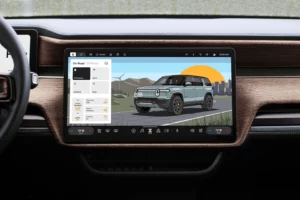
Rivian and Volkswagen join forces to tackle EV software
By onAnnouncements | Technology
Rivian and Volkswagen Group are working together to create a software-defined vehicle (SDV) platform for future electric vehicles (EVs) manufactured by both companies.
According to a recent news release, Volkswagen invested an initial $1 billion in Rivian. The company plans to invest an additional $4 billion during the venture.
“The partnership is anticipated to accelerate the development of software for Rivian and Volkswagen Group,” the release says. “It is expected to allow both companies to combine their complementary strengths and lower cost per vehicle by increasing scale and speeding up innovation globally.”
The foundation of the SDV will be Rivian’s in-market zonal hardware design and technology platform, the release says. The company also plans to contribute its electrical architecture expertise and is expected to license existing intellectual property rights to the venture.
Both companies could launch vehicles with the created technology in the second half of the decade, the release says. In the short term, Volkswagen will enable Rivian’s existing electrical architecture and software platform.
“Our customers benefit from the targeted partnership with Rivian to create a leading technology architecture,” said Oliver Blume, Volkswagen Group CEO, in the release. “Through our cooperation, we will bring the best solutions to our vehicles faster and at lower cost. We are also acting in the best interest of our strong brands, which will inspire with their iconic products. The partnership fits seamlessly with our existing software strategy, our products, and partnerships. We are strengthening our technology profile and our competitiveness.”
RJ Scaringe, Rivian founder and CEO, said in the release that the company is excited to see its technology recognized by a respected automotive company.
“Not only is this partnership expected to bring our software and associated zonal architecture to an even broader market through Volkswagen Group’s global reach, but this partnership also is expected to help secure our capital needs for substantial growth,” Scaringe said. “Rivian was created to help the world to transition away from fossil fuels through compelling products and services, and this partnership is beautifully aligned with that mission.”
The release notes Volkswagen has validated that Rivian’s electrical architecture and software are compatible with the company’s vehicles.
Nissan and Mitsubishi announced earlier this year plans to work together on an electric truck. The business plan doesn’t provide many details about the truck. It is described as a one-ton pickup with Mitsubishi utilizing Nissan EV assets in North America. Globally, the two could work together to produce an electric or plug-in hybrid truck.
A panel at the Consumer Electronics Show (CES) in January discussed how collaboration is key for OEMs to keep up with rapidly changing software.
Elmar Pritsch, partner at Deloitte Consulting, started “The New Age of Auto – from Steel & Exhaust to Software & Sustainability” discussion by noting vehicles today, on average, have 40 times more lines of code than the 2.6 billion lines of code in a Boeing 777.
Pritsch said more OEMs are taking a “risk” on developing their own software.
Last year, Ford announced the hiring of Apple’s Vice President of Services Peter Stern to lead software-enabled experiences. Mike Abbott, another former Apple executive, was named GM’s executive vice president of software.
“Usually OEMs design and build, while the suppliers provide the components and software and now we hear more and more OEMs are taking a look at the software,” Pritsch said.
He asked suppliers on the panel, “How do you cope with the situation?”
Mariella Minutolo, ETAS-Bosch executive vice president of sales, responded that decoupling hardware and software has been a focus of the industry in recent years.
“We’re not there yet and aren’t able to say, ‘We as an industry have found a solution to have it all and be successful in software,’” Minutolo said. “We need collaboration and decoupling of software and hardware is one step to really enable collaboration across the industry.”
Andrew Poliak, Panasonic Automotive chief technology officer, echoed Minutolo’s thoughts on decoupling.
“Some people, they would think, were well into software-defined vehicles,” Poliak said. “But realistically, there’s still a shift that needs to take place, and we’re still in the early days of OEMs and Tier Ones moving to that shift — moving from hardware first and hardware-focused manufacturing to software-driven innovation.”
However, the shift is happening because OEMs have to adapt quickly to the speed of technology, he said.
“You can’t just launch something and expect 11 years later that it will still be relevant without some way of embracing not just software, but even hardware upgradeability,” Poliak said.
Decoupling allows you to start working on software instead of waiting for the hardware to be complete, he said.
“You mentioned that millions of lines of code that are in these systems,” Pollak said referring to Pritsch’s first statements, “The integration effort — the development effort — cannot wait until you have your first sample hardware.”
Integration between mechanical and software teams is also important for cybersecurity, speakers during an SAE International discussion recently said.
Qadeer Ahmed, assistant professor with the Department of Mechanical and Aerospace Engineering at Ohio State University, said students in his department are being taught how to work with software teams from the start of a project.
“We are essentially educating students that hardware and software students need to listen to each other,” Ahmed said.
Sometimes, engineers and developers are just focused on getting the project up and running, Ahmed said. He said they aren’t thinking about the add-ons, backcodes, or external devices that will be working with their project.
IMAGES
Photo courtesy of Rivian
